Statistical release: October to December 2019 (quarter 3, 2019 to 2020)
Updated 4 September 2020
Housing Benefit (HB) is an income related benefit that is intended to help meet housing costs for rented accommodation.
This summary contains statistics on the average time taken to process new claims and change of circumstances claims for this benefit (speed of processing). The average used is the mean and is measured in calendar days, rounded to the nearest day.
For the first time, annual data (covering the year up to each point) has been included to illustrate the trend over time. Throughout this summary this will be referred to as year end figures and are also measured in calendar days, rounded to the nearest day.
1. Main stories
The main stories are:
-
in quarter 3 of the financial year 2019 to 2020, 94% of Housing Benefit claims processed were change of circumstances to existing Housing Benefit claims and the remaining 6% were new Housing Benefit claims. This proportion has changed from quarter 1 of 2011 to 2012 when the proportion of new claims was 17%
-
the average time taken to process a new Housing Benefit claim during quarter 3 of the financial year 2019 to 2020 was 16 calendar days. This is 4 days lower than in the same quarter of 2018 to 2019 and the lowest level since quarter 1 of 2011 to 2012
-
the average time taken to process a change of circumstances to an existing Housing Benefit claim during quarter 3 of the financial year 2019 to 2020 was 6 calendar days. This is 2 days lower than quarter 3 of 2018 to 2019 and the lowest it has been for that quarter.
2. What you need to know
National, Official and Experimental statistics are produced in accordance with the Statistics and Registration Service Act 2007 and the Code of Practice for Statistics (the Code).
This release contains Official Statistics on speed of processing of HB claims for quarter 3 of 2019 to 2020. They are compiled following the standards of trustworthiness, quality and public value set out within the Code.
The statistics are released quarterly in April, July, October and January and are sourced from data originally collected via administrative systems (Single Housing Benefit Extract).
The statistics show Speed of Processing of new claims and change of circumstances claims. Volumes of new claims and change of circumstances claims are also included here for context.
Further information and detailed tables, including a breakdown by local authority (LA), can be viewed in the collection of Housing Benefit speed of processing statistics.
Genuine variations between months can occur at a LA level. For example, some of these are caused by time limited issues or localised changes in operational policy. Hence, figures for individual LAs should be interpreted with care.
Quarterly totals may not be entirely consistent with monthly figures, as any LAs that do not have data for every month of the quarter are not included in the quarterly breakdowns. Year end figures include data over the previous 12 months, but there may be inconsistencies where LAs do not have available data for the period.
From April 2013, Universal Credit (UC) was introduced. The process began with single claimants and was expanded to other claimant types via the UC Full Service (UCFS). The UCFS rollout was completed in December 2018 and it is now available in every jobcentre across the UK.
Read the rollout schedule for Full Service. UCFS implementation dates for each LA are provided in the supporting tables for this release.
Read the background information note for further information on the methodology and the quality of the data.
3. New claims and change of circumstances claims
LAs process on average a greater number of change of circumstances claims than new claims and this difference is reflected at the Great Britain level in the following table.
Figure 1: New claims and change of circumstances claims processed in Great Britain (quarter 3 for 2019 to 2020)
| Type of claim | Number of claims processed (millions) |
|---|---|
| New claims | 0.1 |
| Change of circumstances claims | 1.4 |
During quarter 3 of 2019 of 2020 there were 0.1 million new HB Claims and 1.4 million change of circumstances to existing HB claims processed in Great Britain. For new HB claims there has been a decrease of 8,000 (8%) since the last quarter and a decrease of 61,000 (40%) since quarter 3 of 2018 to 2019.
The same pattern is present for change of circumstances to existing HB claims, with a decrease of 430,000 (23%) since the last quarter and a decrease of 470,000 (25%) since quarter 3 of 2018 to 2019.
Figure 2: Number of change of circumstances claims processed in Great Britain up to quarter 3, 2019 to 2020

The darker lines in Figure 2 refer to quarterly figures on the volume of change of circumstances claims.
The volume of change of circumstances claims have decreased from 2.2 million in quarter 3 of 2011 to 2012 to 1.4 million in quarter 3 of 2019 to 2020. Year end figures shows considerable variability in the volume of change of circumstances claims but since quarter 3 of 2015 to 2016 the volumes are following a downward trend.
Figure 3: Number of new claims processed in Great Britain up to quarter 3 of 2019 to 2020
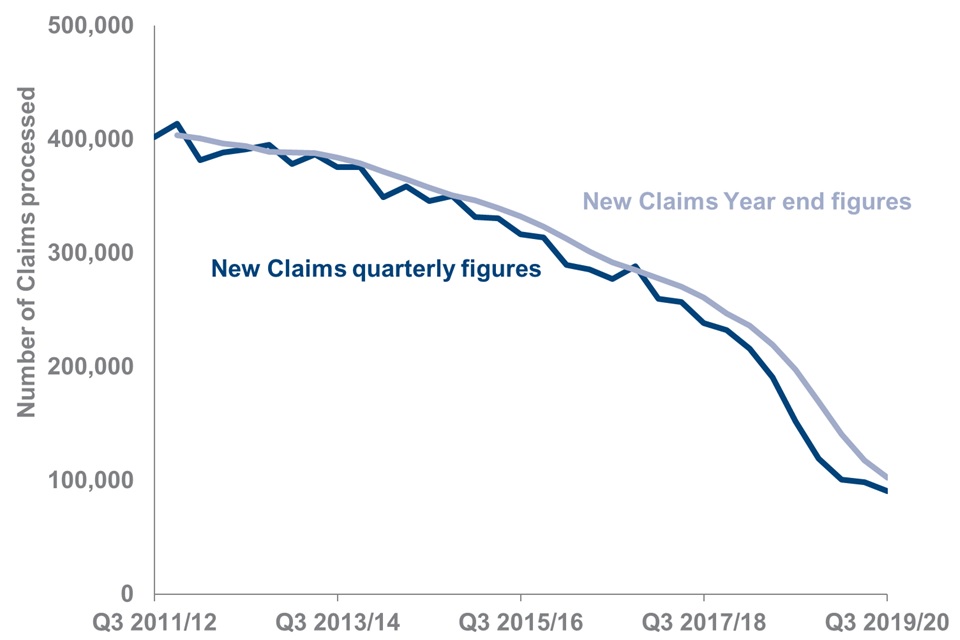
The darker lines in Figure 3 refer to quarterly figures on the volume of new claims.
The volume of new claims has decreased from 400,000 in quarter 3 of 2011 to 2012 to 91,000 in quarter 3 of 2019 to 2020. This follows a decreasing trend since 2011 to 2012, reflected in the year end figures for new claims.
These changes are due to the impact of the UC roll-out which has affected figures reported at a LA level. Both the volumes of new HB claims and change of circumstances to existing HB claims are decreasing however, at different rates, because of the change in the types of claims being processed. It should be noted that care should be exercised when interpreting data at a LA level in the accompanying tables.
In quarter 4 each year, the volume of change of circumstances claims increases sharply which is due to the end of the financial year before the uprating of rent.
At quarter 3 2019 to 2020:
- 94% of all HB claims processed in Great Britain were change of circumstances to existing HB claims, an increase of 1% from quarter 3 of 2018 to 2019
- 6% of all HB claims were new HB claims, a decrease of 1% from quarter 3 of 2018 to 2019
Figure 4 shows the proportions for both types of claims have been changing gradually since the introduction of UC. There is a moderate upward trend in the proportion of change of circumstances to existing HB claims, as reflected in the year end figures, and year end figures show there is a slight downward trend in the proportion for new HB claims.
Figure 4: Proportion of new claims and change of circumstances claims processed in Great Britain up to quarter 3 2019 to 2020

4. Average Housing Benefit speed of processing
Figure 5: Speed of processing for new claims and change of circumstances claims processed in Great Britain up to quarter 3 of 2019 to 2020
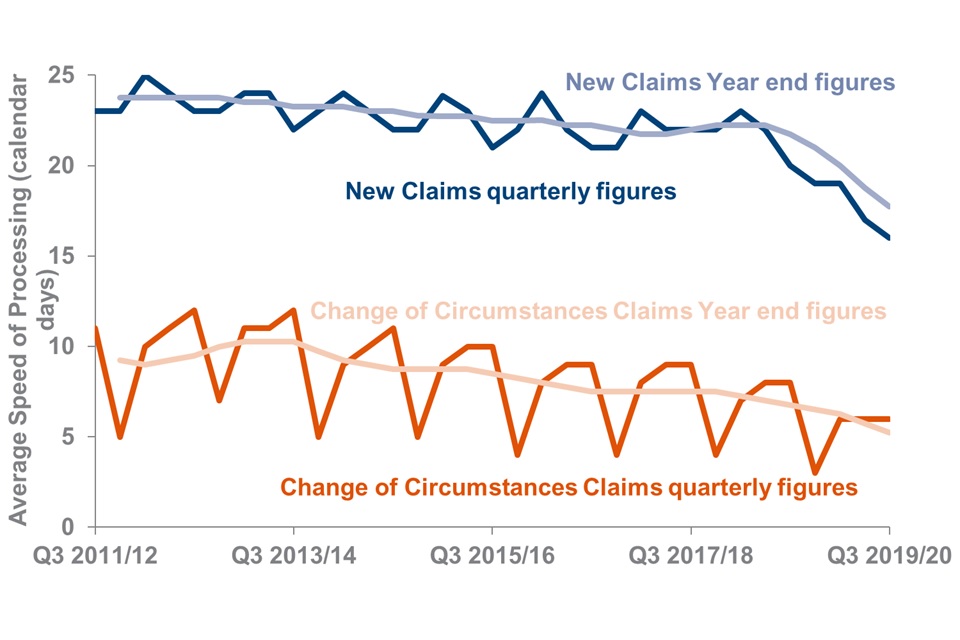
The darker lines in Figure 5 refer to quarterly figures on the average speed of processing for new claims and change of circumstances claims.
The average time taken to process a new Housing Benefit claim during quarter 3 of the financial year 2019 to 2020 was 16 calendar days. This is 4 days lower than in the same quarter of 2018 to 2019 and the lowest it has been since quarter 1 of 2011 to 2012.
The speed of processing for a change of circumstances to an existing Housing Benefit claim during quarter 3 of the financial year 2019 to 2020 was 6 calendar days. This is 2 days less than quarter 3 of 2018 to 2019 and the lowest it has been for that quarter.
Year end figures peaked for new claims in quarter 4 of 2011 to 2012 with an average of 24 calendar days but change of circumstances claims peaked in quarter 1 of 2013 to 2014 with an average of 10 days. Speed of processing has declined for both claims since that peak.
The number of change of circumstances claims increases and the speed of processing decreases in quarter 4 each year. This is a period where LAs tend to allocate extra resources to process more change of circumstances claims from tenants, which leads to a decrease in the speed of processing, and a comparatively lower average speed of processing for new claims.
In the other quarters of the year, the volume of these change of circumstances claims tends to decrease which results in a higher average speed of processing.
Figure 6: Speed of processing for new claims and change of circumstances claims processed in Great Britain up to December 2019
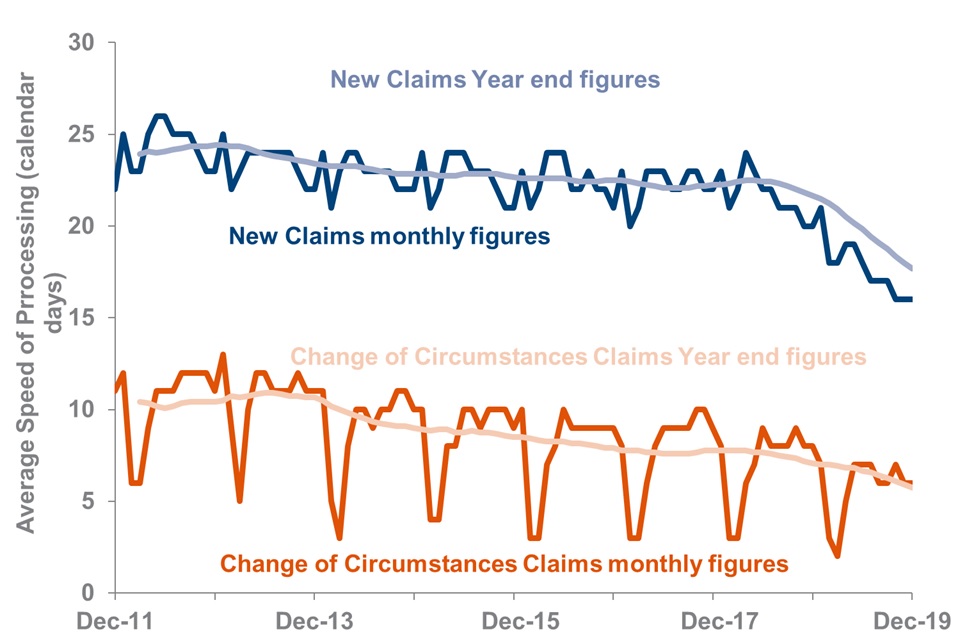
The darker lines in Figure 6 refer to monthly figures on the average speed of processing for new claims and change of circumstances claims.
There was little monthly variation in processed volumes and speed of processing for new HB claims and change of circumstances to existing HB claims during quarter 3 of 2019 to 2020.
The monthly average time taken to process new HB claims was:
- 16 calendar days for October
- 16 calendar days for November
- 16 calendar days for December
Processing time for year end figures at December 2019 for new HB claims is 18 days which is 4 days less than the same month in 2018.
The monthly average time taken to process change of circumstances to existing HB claims was:
- 7 calendar days for October
- 6 calendar days for November
- 6 calendar days for December
The year end figures for the processing time for change of circumstances to existing HB claims at December 2019 was 1 day less than for year end December 2018. This shows little change in the processing time over this period.
5. Average Housing Benefit speed of processing by local authority
Figure 7: Average speed of processing for a new HB claim by LA
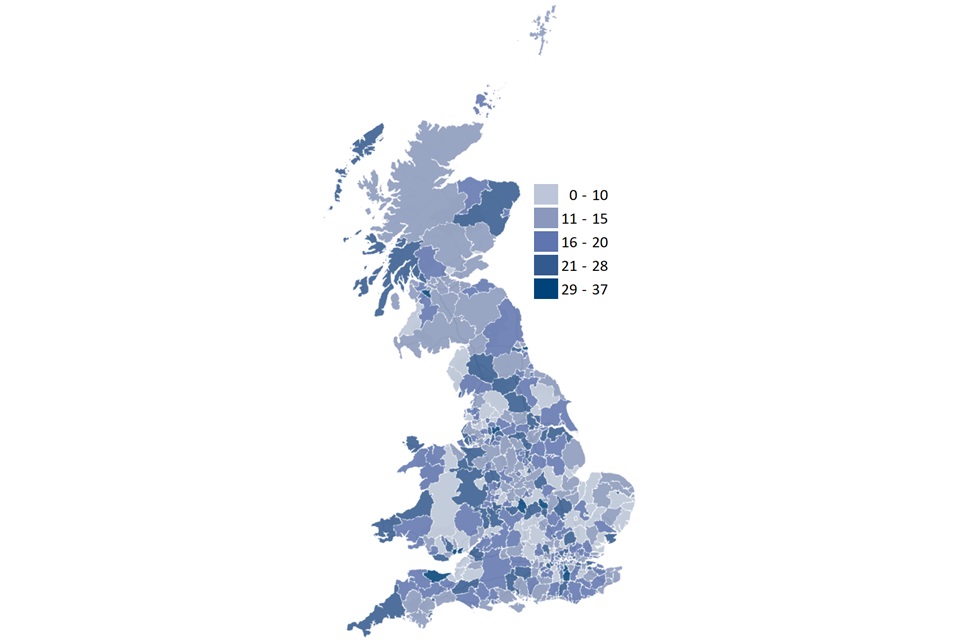
Figure 8: Average speed of processing for a change of circumstances to an existing HB claim by LA
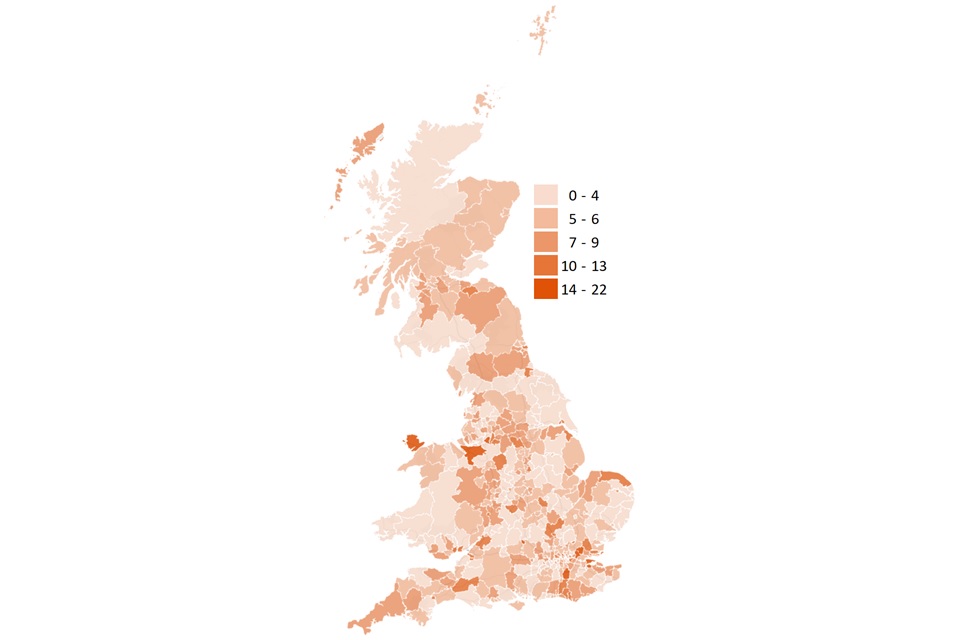
The maps show the average speed of processing for a new HB claim or change of circumstances to an existing HB claim. The average number of days taken to process either a new claim or a change of circumstances claim varies widely between LAs. LAs that take longer to process a new claim or change of circumstances claim being represented by a darker colour in the map.
On average a new claim takes longer to process than a change of circumstances claim. Detailed figures in the accompanying tables show greater variability for new claims in comparison to change of circumstances claims. There could be different reasons or operational factors for the variations between the number of days that each LA takes to process a new claim and a change of circumstances claim.
6. Where to find out more
Historical data
The historical Housing Benefit & Council Tax Benefit claims administration quarterly performance data which is available to 2007 to 2008 are based on clerical returns made by individual local authorities.
Breakdowns of new claims and change of circumstances claims speed of processing are available historically, and the new claims speed of processing are broadly comparable over time. However, a change in definition for change of circumstances between 2007 to 2008 and 2009 to 2010 means that direct comparison of this element with speed of processing statistics is not meaningful.
Read the background information and frequently asked questions on statistics for the average time taken to process HB (previously right time indicator statistics) on statistics for the average time taken to process HB claims (previously right time indicator).
Read the dwp statistical summary policies and statements for information about policies and procedures on DWP National and Official Statistics, including a quality guideline, confidentiality and access policy statement, pre-release access arrangements and statement of administrative sources.
Other National and Official Statistics
The Department for Work and Pensions (DWP) also publish the HB caseload National Statistics that have been used in this release. The statistics are published quarterly showing monthly caseload figures which are measured on a claimant basis.
HB caseload data is now only released on Stat-Xplore, statistics on HB caseload since August 2013 are available
HB caseload data tables (to May 2018 only) are available in spreadsheet format.
Read details about other DWP National and Official Statistics.
Feedback
DWP welcomes feedback on all the statistical publications as it ensures that publications remain relevant to the users. Please use this questionnaire to send us any comments you may have on this publication. DWP will use the information to:
- target future consultations at interested users
- shape the future direction of statistics development to address user needs
- help ensure value for money, whilst giving users a structured way of expressing their views
Completed questionnaires can be returned by e-mail to stats-consultation@dwp.gov.uk or by post to the following address:
Client Statistics Team
Data as Statistics
Department for Work and Pensions
Room BP5201
Benton Park Road
Longbenton
Newcastle upon Tyne, NE98 1YX
Users can also join the Stats UserNet “Welfare and Benefit Statistics” community. DWP announces items of interest to users via this forum, as well as replying to users’ questions.
Press enquiries should be directed to DWP Press Office, telephone: 0203 267 5144.
Other enquiries about these statistics should be directed by email to:
- producer of this release: molly.lamb@dwp.gov.uk
- lead statistician: yolanda.ruizrodriguez@dwp.gov.uk
ISBN: 978-1-78659-223-1
